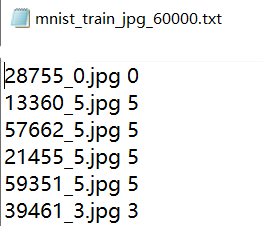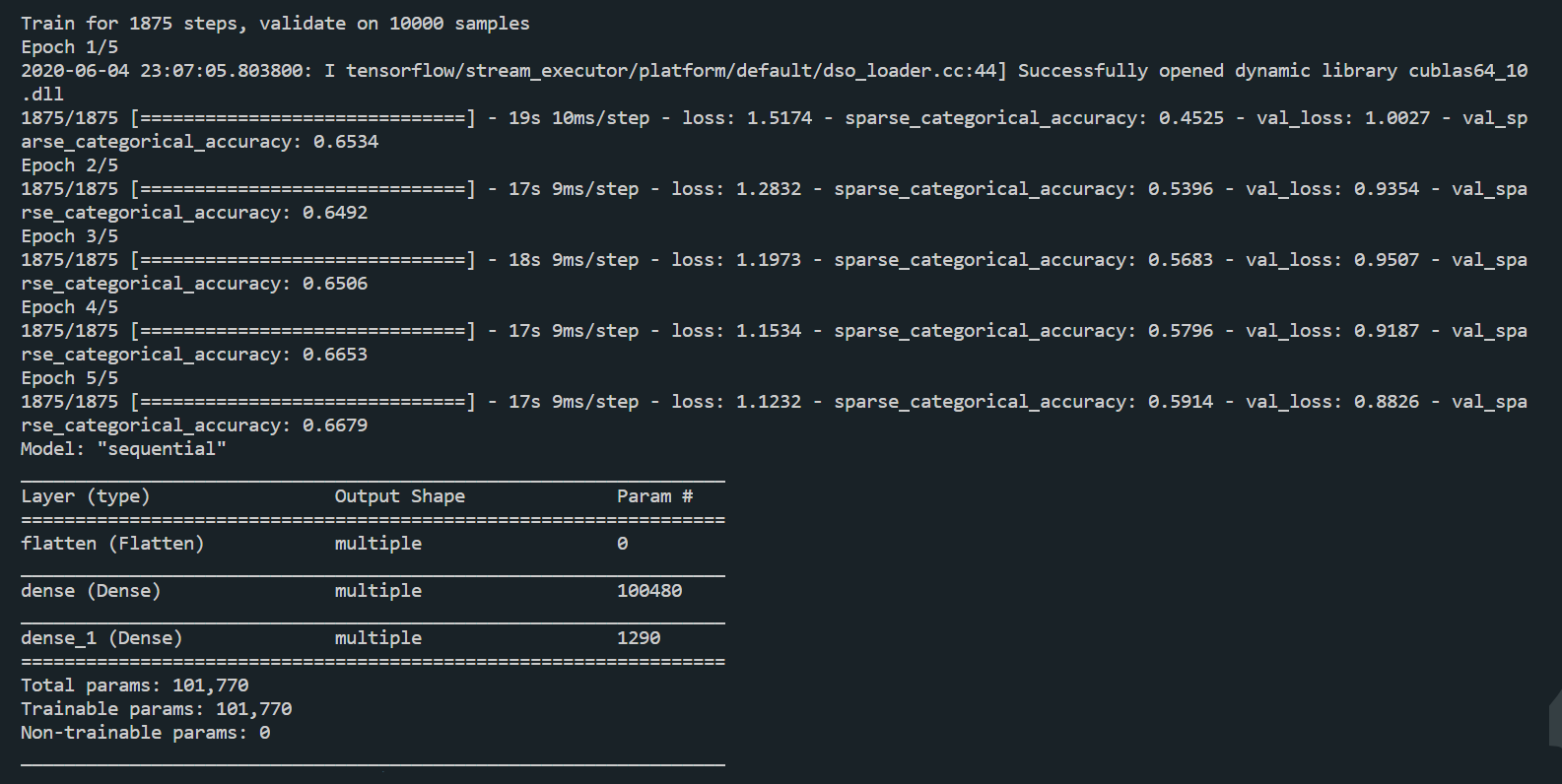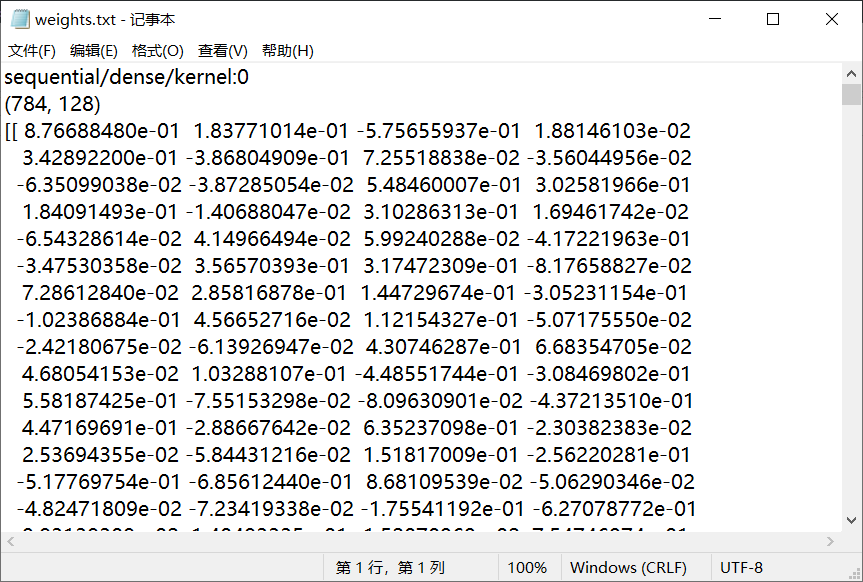TensorFlow2.1入门学习笔记(11)——自制数据集,并记录训练模型

Contents
以MNIST的sequential模型为base-line,通过读取自己的数据,训练模型并存储模型,最后达到绘图实物的运用。
1 自制数据集,解决本领域应用
1.1 观察数据结构
给x_train、y_train、x_test、y_test赋值

1.2 def generateds(图片路径,标签文件):
def generateds(path, txt):
f = open(txt, 'r') # 以只读形式打开txt文件
contents = f.readlines() # 读取文件中所有行
f.close() # 关闭txt文件
x, y_ = [], [] # 建立空列表
for content in contents: # 逐行取出
value = content.split() # 以空格分开,图片路径为value[0] , 标签为value[1] , 存入列表
img_path = path + value[0] # 拼出图片路径和文件名
img = Image.open(img_path) # 读入图片
img = np.array(img.convert('L')) # 图片变为8位宽灰度值的np.array格式
img = img / 255. # 数据归一化 (实现预处理)
x.append(img) # 归一化后的数据,贴到列表x
y_.append(value[1]) # 标签贴到列表y_
print('loading : ' + content) # 打印状态提示
x = np.array(x) # 变为np.array格式
y_ = np.array(y_) # 变为np.array格式
y_ = y_.astype(np.int64) # 变为64位整型
return x, y_ # 返回输入特征x,返回标签y_2 数据增强,扩充数据集
数据增强(增大数据量),可以简单的扩展数据集,对图像的数据增强就是对图像的简单形变。
tensorflow2中的数据增强函数
image_gen_train = tf.keras.preprocessing.image.ImageDataGenerator(
rescale = 所有数据将乘以该数值
rotation_range = 随机旋转角度数范围
width_shift_range = 随机宽度偏移量
height_shift_range = 随机高度偏移量
水平翻转:horizontal_flip = 是否随机水平翻转
随机缩放:zoom_range = 随机缩放的范围 [1-n,1+n] )
image_gen_train.fit(x_train)
### 例 ###
image_gen_train = ImageDataGenerator(
rescale=1. / 1., # 如为图像,分母为255时,可归至0~1
rotation_range=45, # 随机45度旋转
width_shift_range=.15, # 宽度偏移
height_shift_range=.15, # 高度偏移
horizontal_flip=False, # 水平翻转
zoom_range=0.5 # 将图像随机缩放阈量50%)
image_gen_train.fit(x_train)其中image_gen_train.fit(x_train)中的fit需要一个四维数组 即:
x_train = x_train.reshape(x_train[0], 28, 28, 1)(60000, 28, 28) $\Rightarrow$ (60000, 28, 28, 1) 将60000张28行28列的数据转换成60000张28行28列单通道的数据集,其中“1”是灰度值 model.fit()同步更新为model.fit(image_gen_train.flow(x_train, y_train,batch_size=32), ……)
$$\Downarrow$$
加入数据增强的的代码训练后
import tensorflow as tf
from tensorflow.keras.preprocessing.image import ImageDataGenerator
mnist = tf.keras.datasets.mnist
(x_train, y_train), (x_test, y_test) = mnist.load_data()
x_train, x_test = x_train / 255.0, x_test / 255.0
x_train = x_train.reshape(x_train.shape[0], 28, 28, 1) # 给数据增加一个维度,从(60000, 28, 28)reshape为(60000, 28, 28, 1)
image_gen_train = ImageDataGenerator(
rescale=1. / 1., # 如为图像,分母为255时,可归至0~1
rotation_range=45, # 随机45度旋转
width_shift_range=.15, # 宽度偏移
height_shift_range=.15, # 高度偏移
horizontal_flip=False, # 水平翻转
zoom_range=0.5 # 将图像随机缩放阈量50%
)
image_gen_train.fit(x_train)
model = tf.keras.models.Sequential([
tf.keras.layers.Flatten(),
tf.keras.layers.Dense(128, activation='relu'),
tf.keras.layers.Dense(10, activation='softmax')
])
model.compile(optimizer='adam',
loss=tf.keras.losses.SparseCategoricalCrossentropy(from_logits=False),
metrics=['sparse_categorical_accuracy'])
model.fit(image_gen_train.flow(x_train, y_train, batch_size=32), epochs=5, validation_data=(x_test, y_test),
validation_freq=1)
model.summary()- 随着模型迭代轮数的增加,模型的准确率不断提高
- 数据在小数据量上可以增加模型的泛化性
3 断点续训,存取模型
3.1 读取保存模型
load_weights(路径文件名)
checkpoint_save_path = "./checkpoint/fashion.ckpt" #先定义出存放模型的路径和文件名,“.ckpt”文件在生成时会同步生成索引表
if os.path.exists(checkpoint_save_path + '.index'): #判断是否有索引表,就可以知道是否报存过模型,如果有索引表,就会调用load_weights()即模型
print('-------------load the model-----------------')
model.load_weights(checkpoint_save_path)3.2 保存模型
使用tensorflow给出的回调函数直接保存训练的参数:
tf.keras.callbacks.ModelCheckpoint(filepath=路径文件名,save_weights_only=True/False,save_best_only=True/False)
history = model.fit( callbacks=[cp_callback] )
cp_callback = tf.keras.callbacks.ModelCheckpoint(filepath=checkpoint_save_path, # 文件存储路径
save_weights_only=True, # 是否只保留模型参数
save_best_only=True) # 是否只保留模型最优参数
history = model.fit(x_train, y_train, batch_size=32, epochs=5, # 加入callbacks选项,记录到history中
validation_data=(x_test, y_test), validation_freq=1,
callbacks=[cp_callback])加入断点续训的完整代码:
import tensorflow as tf
import os # 引入os模块,(文件处理)
mnist = tf.keras.datasets.mnist
(x_train, y_train), (x_test, y_test) = mnist.load_data()
x_train, x_test = x_train / 255.0, x_test / 255.0
model = tf.keras.models.Sequential([
tf.keras.layers.Flatten(),
tf.keras.layers.Dense(128, activation='relu'),
tf.keras.layers.Dense(10, activation='softmax')
])
model.compile(optimizer='adam',
loss=tf.keras.losses.SparseCategoricalCrossentropy(from_logits=False),
metrics=['sparse_categorical_accuracy'])
checkpoint_save_path = "./checkpoint/fashion.ckpt"
if os.path.exists(checkpoint_save_path + '.index'):
print('-------------load the model-----------------')
model.load_weights(checkpoint_save_path)
cp_callback = tf.keras.callbacks.ModelCheckpoint(filepath=checkpoint_save_path,
save_weights_only=True,
save_best_only=True)
history = model.fit(x_train, y_train, batch_size=32, epochs=5, validation_data=(x_test, y_test), validation_freq=1,
callbacks=[cp_callback])
model.summary()第一次运行:
第二次运行:
加载了第一次保存的参数,准确率在第一次的基础上提高
4 参数提取,把参数存入文本
- 提取可训练参数 model.trainable_variables 返回模型中可训练的参数
- 设置print输出格式 np.set_printoptions(threshold=超过多少省略显示)
np.set_printoptions(threshold=np.inf) # np.inf表示无限大- 将可训练参数存入文本
print(model.trainable_variables)
file = open('./weights.txt', 'w')
for v in model.trainable_variables:
file.write(str(v.name) + '\n')
file.write(str(v.shape) + '\n')
file.write(str(v.numpy()) + '\n')
file.close()在断点续训的基础上加入参数提取
import tensorflow as tf
import os
import numpy as np
np.set_printoptions(threshold=np.inf)
mnist = tf.keras.datasets.mnist
(x_train, y_train), (x_test, y_test) = mnist.load_data()
x_train, x_test = x_train / 255.0, x_test / 255.0
model = tf.keras.models.Sequential([
tf.keras.layers.Flatten(),
tf.keras.layers.Dense(128, activation='relu'),
tf.keras.layers.Dense(10, activation='softmax')
])
model.compile(optimizer='adam',
loss=tf.keras.losses.SparseCategoricalCrossentropy(from_logits=False),
metrics=['sparse_categorical_accuracy'])
checkpoint_save_path = "./checkpoint/fashion.ckpt"
if os.path.exists(checkpoint_save_path + '.index'):
print('-------------load the model-----------------')
model.load_weights(checkpoint_save_path)
cp_callback = tf.keras.callbacks.ModelCheckpoint(filepath=checkpoint_save_path,
save_weights_only=True,
save_best_only=True)
history = model.fit(x_train, y_train, batch_size=32, epochs=5, validation_data=(x_test, y_test), validation_freq=1,
callbacks=[cp_callback])
model.summary()
print(model.trainable_variables)
file = open('./weights.txt', 'w')
for v in model.trainable_variables:
file.write(str(v.name) + '\n')
file.write(str(v.shape) + '\n')
file.write(str(v.numpy()) + '\n')
file.close()运行得到weights.txt文件
5 acc/loss可视化,查看训练效果
- 将训练过程可视化出来 在history中同步记录了训练集loss、测试机loss、训练集准确率和测试集准确率
- history=model.fit(训练集数据, 训练集标签, batch_size=, epochs=,validation_split=用作测试数据的比例,validation_data=测试集,validation_freq=测试频率)
- history 训练集loss: loss 测试集loss: val_loss 训练集准确率: sparse_categorical_accuracy 测试集准确率: val_sparse_categorical_accuracy
acc = history.history['sparse_categorical_accuracy']
val_acc = history.history['val_sparse_categorical_accuracy']
loss = history.history['loss']
val_loss = history.history['val_loss'] #使用history.histor[]提取加入绘制图像的代码:
import tensorflow as tf
import os
import numpy as np
from matplotlib import pyplot as plt # 导入绘图模块
np.set_printoptions(threshold=np.inf)
mnist = tf.keras.datasets.mnist
(x_train, y_train), (x_test, y_test) = mnist.load_data()
x_train, x_test = x_train / 255.0, x_test / 255.0
model = tf.keras.models.Sequential([
tf.keras.layers.Flatten(),
tf.keras.layers.Dense(128, activation='relu'),
tf.keras.layers.Dense(10, activation='softmax')
])
model.compile(optimizer='adam',
loss=tf.keras.losses.SparseCategoricalCrossentropy(from_logits=False),
metrics=['sparse_categorical_accuracy'])
checkpoint_save_path = "./checkpoint/fashion.ckpt"
if os.path.exists(checkpoint_save_path + '.index'):
print('-------------load the model-----------------')
model.load_weights(checkpoint_save_path)
cp_callback = tf.keras.callbacks.ModelCheckpoint(filepath=checkpoint_save_path,
save_weights_only=True,
save_best_only=True)
history = model.fit(x_train, y_train, batch_size=32, epochs=5, validation_data=(x_test, y_test), validation_freq=1,
callbacks=[cp_callback])
model.summary()
print(model.trainable_variables)
file = open('./weights.txt', 'w')
for v in model.trainable_variables:
file.write(str(v.name) + '\n')
file.write(str(v.shape) + '\n')
file.write(str(v.numpy()) + '\n')
file.close()
############################################### show ###############################################
# 显示训练集和验证集的acc和loss曲线
acc = history.history['sparse_categorical_accuracy']
val_acc = history.history['val_sparse_categorical_accuracy']
loss = history.history['loss']
val_loss = history.history['val_loss']
plt.subplot(1, 2, 1)
plt.plot(acc, label='Training Accuracy')
plt.plot(val_acc, label='Validation Accuracy')
plt.title('Training and Validation Accuracy')
plt.legend()
plt.subplot(1, 2, 2)
plt.plot(loss, label='Training Loss')
plt.plot(val_loss, label='Validation Loss')
plt.title('Training and Validation Loss')
plt.legend()
plt.show()可视化结果:
6 应用程序,给图识物
前面已经将模型训练好了,下面将编写一套运用程序实现给图识物
- predict(输入特征,batch_size=整数) 返回前向传播计算结果
前向传播执行应用:
- 复现模型(前向传播)
- 加载参数:model.load_weights(model_save_path)
- 预测结果:result = model.predict(x_predict)
源码:
from PIL import Image
import numpy as np
import tensorflow as tf
model_save_path = './checkpoint/mnist.ckpt'
model = tf.keras.models.Sequential([ # 复现网络
tf.keras.layers.Flatten(),
tf.keras.layers.Dense(128, activation='relu'),
tf.keras.layers.Dense(10, activation='softmax')])
model.load_weights(model_save_path) # 加载参数
preNum = int(input("input the number of test pictures:")) # 准备预测多少个数
for i in range(preNum): # 读入待识别的图片
image_path = input("the path of test picture:")
img = Image.open(image_path)
img = img.resize((28, 28), Image.ANTIALIAS) # 转换成(28,28)的类型,与训练数据类型匹配
img_arr = np.array(img.convert('L')) # 转换成灰度图
img_arr = 255 - img_arr # 将“白底黑字”反转成“黑底白字”
#####or#####
# for i in range(28): # 转换成高对比度的图,过滤噪声
# for j in range(28):
# if img_arr[i][j] < 200:
# img_arr[i][j] = 255
# else:
# img_arr[i][j] = 0
img_arr = img_arr / 255.0 # 归一化
print("img_arr:",img_arr.shape)
x_predict = img_arr[tf.newaxis, ...] # 由于是按每个batch送入网络,故添加一个维度
print("x_predict:",x_predict.shape)
result = model.predict(x_predict) #预测结果
pred = tf.argmax(result, axis=1)
print('\n')
tf.print(pred)






